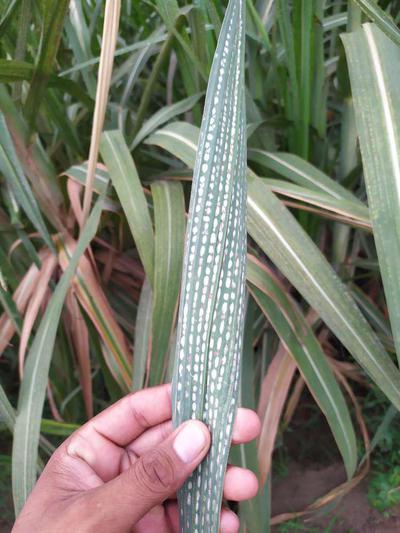Sugarcane Leaf Mite
Schizotetranychus andropogoni
Mite
In a Nutshell
- White webs on the ventral surface of the leaves.
- Appearance of white patches due to feeding by mites.
Can also be found in
Symptoms
Webs are formed all over the underside of the leaf parallel to the midrib. The population of webs is higher towards the tips. Newly-formed webs are whitish in colour, but later turn brown and are ultimately blown off from the surface of the leaf, with white patches being left behind. The mites feed by scraping the epidermis and sucking the juice. Heavily infested leaves give a sickly appearance and later dry up completely. Colonies appear grayish due to webbing, cast skins and soil particles caught in the webbing under the surface of the leaf. Mites can be seen on the undersurface of leaves making small oval colonies covered with thin webs and arranged irregularly on either side of the midrib. Survival of webbed colonies in the plants under adverse climatic conditions contributes to their subsequent rapid population increase.
Recommendations

Organic Control
A thysanopterous predator known as Scolothrips indicus Pr is a natural enemy capable of destroying the mite-eggs within the webs. Spray the crop with lime-sulphur, or fish oil rosin soap. Spraying with Kelthane can also be effective.

Chemical Control
Always consider an integrated approach together with preventive measures together with biological treatments, if available. Spray crop with a miticide along with miscible liquid.
What caused it?
Damage is caused by the mites. Copulation takes place immediately after the last moult. Eggs are laid singly within the webs which get attached to the leaves. Egg laying begins about 24 hours after mating. About 40-60 eggs are laid by a single female. The duration of the nymphal stage varies between 10-12 days. There are three nymphal stages before the attainment of full maturation. The activity of the mites declines significantly during the winter seasons and remains as such till the beginning of summer.
Preventive Measures
- Clip infested sugarcane leaves in the initial stages of pest infestation.
- Remove weeds especially graminaceous ones like Sorghum halepense (Baru grass) from in and around the sugarcane field.



